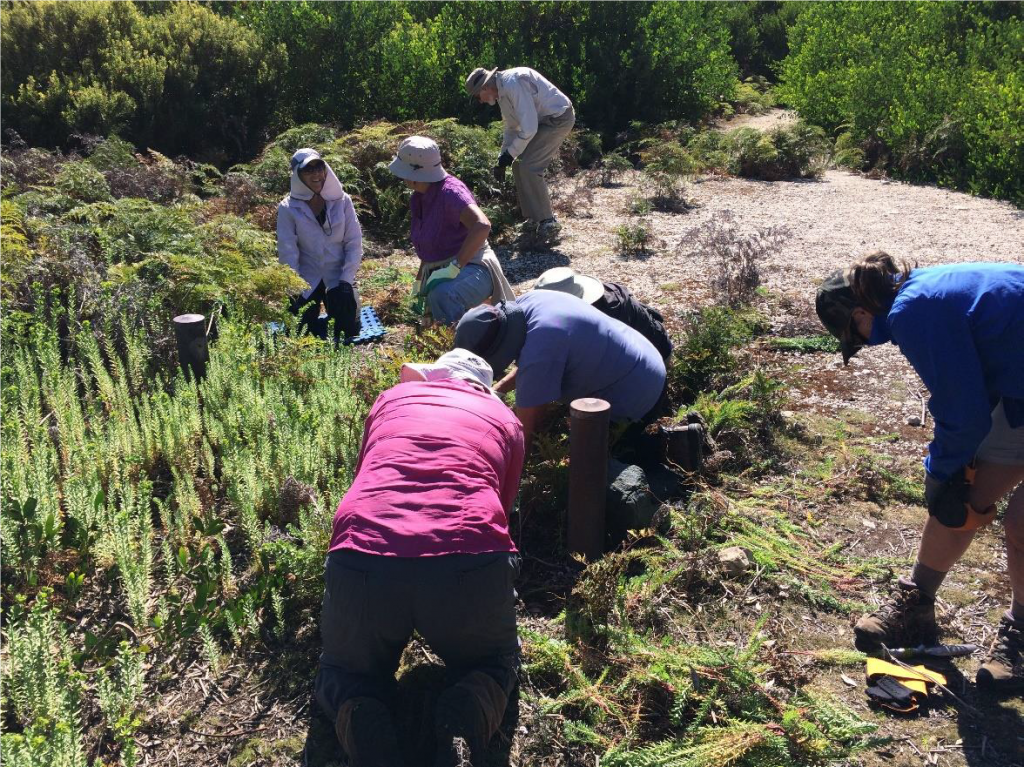Friends of Narawntapu
By Helen Plaister, President (extract from The Newsletter of the Rubicon Key Biodiversity Area)
SEA SPURGE (Euphorbia paralias) is a well- established weed within the coastal dunes of Narawntapu National Park. The prevalence of the weed is at its highest in dune complexes of both Bakers and Badger Beach. It is also present in suitable habitat around little Badger Head and Copper Cove. It extends from Bakers Point on the western side of the Park and occupies suitable sandy substrates through to West Head. Anecdotally it will continue to push southwards. The problem is its very existence is putting pressure on the availability of nesting sites for our Tasmanian shorebirds.

Background
In November 2015 I saw there was a possibility of helping PWS deal with the sea spurge problem that exists at Narawntapu and formed a partnership between Wildcare Tasmania, Sea Spurge Remote Areas Teams (SPRATS) and the Parks and Wildlife Service (PWS).
In 2016 under the guidance of the PWS team we set up a weeding program involving, on average, 7 volunteers. We attempted to weed, in our first year, 2 days a month. We targeted an area between Griffith point and Bakers point – a distance of 2.5kms. The aim was to hand-weed the sea spurge, maping the area, record relevant data, and observe and count the seas birds as we went. This was a trial to see if hand weeding was at all effective. The volunteers came originally from two bush walking groups and interested friends.
The PWS personnel were the parks ranger Clinton Dowling, assistant rangers Ted Bugg(now transferred to the Ulverstone office) and Daniel Bowden.
The results:
2016
7 weeding sessions were held with an average of 7 people working for 42 people hours each. 343 person hours in total and approximately 214,733,000 (nearly a quarter of a million plants hand weeded).
2017
5 weeding sessions 249 hours 25000 plants
1 week camp held. Total for that camp was 334 person hours weeding 3,965,000 plants.
2018
Was difficult; as the coordinator, I was unable to devote time to the project due to the loss of my brother and my own illness.
However, Daniel Bowden (assistant ranger) spent a good deal of time publishing the ‘Narawntapu National Park Weed Strategy Management Plan 2018’.
This document will form the basis of weed control in the park of which sea spurging is a part.
His conclusion about a sea spurge program was:
- “Long term” the ongoing control is a priority.
- Moderate • Monitor current inland spread of Sea Spurge.
- Conduct spraying or pulling of sea spurge around Griffith’s point, Bakers Point, and beach accesses to improve a natural ‘weed free’ aesthetic of the area.
- Co-ordinate a control strategy if and when funding and manpower resources are allocated.
- Utilise volunteer groups where they are available to hand pull Sea Spurge in the above mentioned areas.
This is an important document as the decision making must rest with PWS.
2019 A new beginning
We are continuing our good work and have set 2 dates on the Wildcare calendar.
They are:
Sunday August 11th
Sunday September 1st.
Hopefully a week long camp will be held later in November.
Anyone interested in volunteering is asked to join Wildcare. Specifically Friends of Narawntapu.
As a member you are covered by Wildcare for insurance and permitted to volunteer in the park.
All volunteer details about requirements for these dates, times and meeting places can be gained from Wildcare: Friends of Narawntapu website, in particular the calendar.
You are required to register if attending any of these sessions.